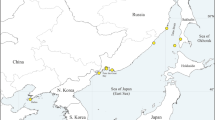Abstract
Rhopilema nomadica is an Indopacific scyphomedusan, which has migrated into the eastern Mediterranean in recent years. Large aggregations of the medusae were recorded in Haifa Bay, Israel, reaching 5.5×105 medusae per square nautical mile during summer 1989. The life cycle of R. nomadica from planula to young medusa is described. Fertilization is external and planulae are formed within a few hours at 20°C. After settlement, polyps were fed with Artemia sp. nauplii and developed into polydisc strobilae within 45 d. The strobilation process was completed within 7 d, and the liberated ephyrae developed into young medusae within 2 mo. Asexual reproduction occurred mainly via podocyst formation. The population explosion of R. nomadica could be attributed to its high reproductive potential.
Similar content being viewed by others
Literature cited
Calder, D.R. (1973). Laboratory observations on the life history of Rhopilema verrilli (Scyphozoa: Rhizostomeae). Mar. Biol. 21: 109–114
Calder, D.R. (1982). Life history of the jellyfish, Stomolophus meleagris L. Agassiz, 1860 (Scyphozoa, Rhizostomida) Biol. Bull. mar. biol. Lab., Woods Hole. 162: 149–162
Galil, B.S., Spanier, E., Ferguson, W.W. (1990). The scyphomedusae of the Mediterranean coast of Israel, including two lessepsian migrants new to the Mediterranean. Zool. Meded., Leiden 64: 95–106
Goy, J., Morand, P., Etienne, M. (1989). Long term fluctuation of Pelagia noctiluca in the western Mediterranean sea. Prediction by climatic variables. Deep-Sea Res. 36(2): 269–280
Jiekang, C., Gengwu, D., Chunyang, L. (1985). Effect of nutritional conditions on the strobilation of edible medusa, Rhopilema esculenta Kishinouye. Shui Chan Xue Bao (J. Fish. China). 9: 321–329
Keen, L.S. (1987). Recruitment of Aurelia aurita (Cnidaria: Scyphozoa) larvae is position-dependent, and independent of conspecific density, within a settling surface Mar. Ecol. Prog. Ser. 38: 151–160
Kramp, P.L. (1961). Synopsis of the medusa of the world. J. mar. biol. Ass. U.K. 40: 1–469
Mayer, A.G. (1910). The Scyphomedusae. In: Mayer, A.G. (ed.) Medusa of the world Vol. III. Carnegie Inst. Wash. 109: 499–735
Roberts, L. (1990). Zebra mussel invasion threatens U.S. waters. Science, N.Y. 249: 1370–1372
Russell, F.S. (1970). Pelagic Scyphozoa, with a supplement to the first volume on Hydromedusae. In: Brown, E.T. (ed.) The medusae of the British Isles. II. Cambridge University Press, Cambridge
Wilkerson, F.P., Dugdale, R. (1983). Possible connection between sewage effluent nitrogen levels and jellyfish blooms. Rep. Workshop jellyfish blooms in the Mediterranean. UNEP, Athens, p. 195–201
Willan, R.C. (1987). The mussel Musculista senhousia in Australasia: another aggressive alien highlights the need for quarantine at ports. Bull. mar. Sci. 41(2): 475–489
Zavodnik, D. (1987). Spatial aggregations of the swarming jellyfish Pelagia noctiluca (Scyphozoa). Mar. Biol. 94: 265–269
Author information
Authors and Affiliations
Additional information
Communicated by O. Kinne, Oldendorf/Luhe
Rights and permissions
About this article
Cite this article
Lotan, A., Ben-Hillel, R. & Loya, Y. Life cycle of Rhopilema nomadica: a new immigrant scyphomedusan in the Mediterranean. Mar. Biol. 112, 237–242 (1992). https://doi.org/10.1007/BF00702467
Accepted:
Published:
Issue Date:
DOI: https://doi.org/10.1007/BF00702467




